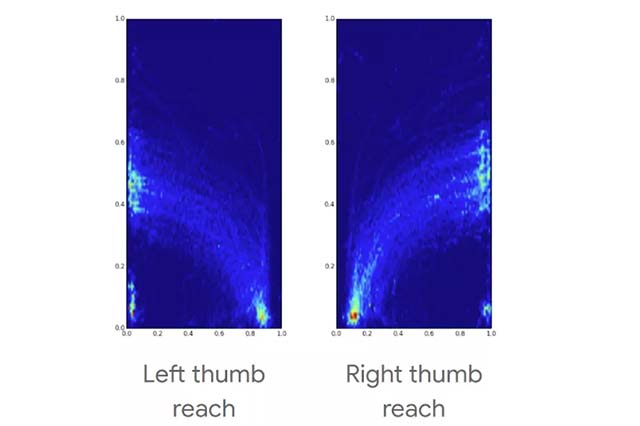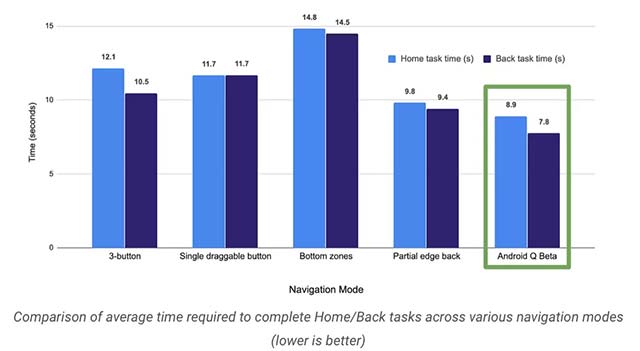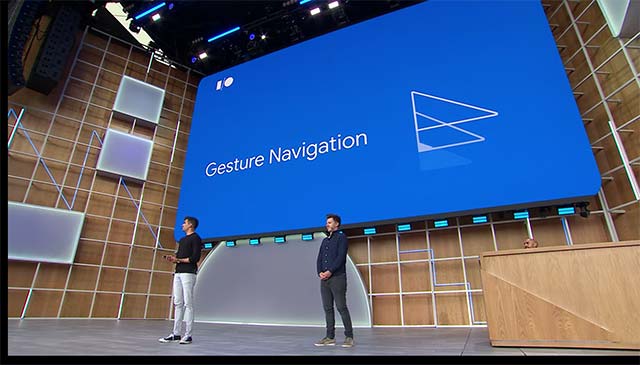Google: Android users prefer to use 3 traditional navigation keys than 'inspired' gesture navigation from iOS
Just one day after the final release of Android Q's beta - Beta 6, Google immediately issued arguments proving why the newly improved gesture navigation operations on Android Q are "a breakthrough compared to the past".
'By switching to the model using touch gestures to navigate the system or because of using the 3 traditional navigation keys, we will have more screen display space for the application, thereby bringing the experience. great experience ', Allen Huang and Rohan Shah, 2 UI Android product managers write on Android Developer blog.
- Google launched Android Q Beta 6 - the final beta
 3 traditional navigation keys on Android
3 traditional navigation keys on Android
The top view of two Google experts received a lot of approval from the Android user community. However, the problem Google encountered is with the 'Back' function on Android. We all know that the 'Back' button is one of the factors that has made the Android brand since the new operating system was launched, and the current Google issue is how to find a way to maintain it. Enough use of this button but in the form of gesture navigation - at the same time turn that solution into a particularly friendly and useful feature for the end user. 'We prioritize this goal more than other frequently used navigation gestures,' said Android managers.
Besides, Google also revealed that they have implemented a lot of research to understand how users hold their phones, as well as how they are compatible with the system of hard keys, touch screens, and which part of the phone is most manipulated by users. From the data collected, the experts have built many real prototype prototypes with the application of some more important factors that can affect the user experience such as manipulation speed, ergonomics .
- Google Maps deploys Live View - an augmented reality (AR) walk through the phone's rear camera
 Gesture navigation model on Android is learned by Google from iOS
Gesture navigation model on Android is learned by Google from iOS
The final design will continue to be tested through a series of studies, such as how quickly users get used to the system, how they feel about the new system, or whether they have any problems. Any inconvenience during use or not.
Below is a thermal chart that shows areas of smartphones where people often feel most comfortable holding the device and performing gestures and gestures with one hand.
- Google will use recycled materials in all its hardware products in the near future
 Heat chart position of thumb when user performs "back" operation
Heat chart position of thumb when user performs "back" operation
As you can see, the research results will lead to a debate about whether the 'Back' navigation operation on the phone by swiping from the side of the screen with the index finger, as Google did in Android Q, Does it feel more comfortable than the back button bruise?
In addition, Google acknowledged that the gesture navigation system they had learned from iOS for quick access to the overview / app recently is to keep it light and swipe up from the bottom of the screen - much slower. Much more than using navigation buttons like before.
The most interesting information is that users really like the ergonomics of the three traditional Android navigation buttons compared to the current gesture navigation. This information is not surprising to many people because since Google introduced the gesture navigation option last year with Android P, there have been many opinions that Mountain View Company should retain navigation feature 3. The traditional button because it is faster, less confusing, and especially makes Android different from iOS.
According to the survey results, the traditional 3-button navigation option received 5.78 ergonomics points, while the gesture navigation on Android Q only received 5.39 ergonomics points.
- Detected 205 malicious applications with more than 32 million downloads on Google Play only in last July
 Comparison chart of user evaluation of ergonomics and using a middle hand between navigation models (higher is more optimal)
Comparison chart of user evaluation of ergonomics and using a middle hand between navigation models (higher is more optimal)
But on the other hand, most users think that new gesture navigation is a better choice in case of using the phone with one hand. Google's statistics show that gesture navigation on Android Q helps people complete tasks when using one hand faster than any other method, even if the user is new and not too fluent. This form of navigation.
'We find that switching to gesture navigation is a big change for users. On average, people usually take 1-3 days to get used to and use the navigation skills proficiently. Even if you are fluent, the wrong operation often happens - especially for gestures such as holding, swipe from the bottom up to access the menu, or swipe from edge to back. previous work ', Google said.
However, in many qualitative studies, experts also found that after the initial acquaintance period of 1-3 days, users became fluent and could more consistently distinguish between gestures direction. Most users don't want to switch back to using the three traditional navigation buttons (though that's still an available option) after being really proficient with gesture navigation.
- Google pays $ 5 to scan pedestrian faces, collecting necessary data for an ambitious new project
 The chart compares the amount of time it takes to complete the main screen / return access operation between navigation models (lower is more optimal).
The chart compares the amount of time it takes to complete the main screen / return access operation between navigation models (lower is more optimal).
Statistics show that people use the back function less frequently during the first few days of trying Android Q and in time to get used to gesture navigation. After that time, the average number of "back" operations (each day) will gradually increase again and be equivalent to when they use 3 traditional navigation buttons.
From all of the above research results, Google understands that users prefer the ergonomics of three more traditional navigation keys, but gesture navigation gives higher use efficiency and especially allows blinds. The display of more content, so the company decided not to return to the traditional 3-key navigation model but will continue to develop and complete gesture navigation. At the same time to avoid market fragmentation and 'conflict' with products from some other manufacturers, the company has confirmed that major Android phone manufacturers include Samsung, LG, OnePlus, Motorola, Xiaomi, HMD Global and Oppo have all agreed to integrate Google's new system by default on devices that come with their Android Q.
However, Google also made it clear that users will still have the right to use the classic 3-button navigation bar on Android Q if desired, but it will have to be activated manually as it is no longer the default.
- Apple, Google, Microsoft, Facebook and Twitter will join a large-scale shared data project
 Google will still focus on improving gesture navigation in the future
Google will still focus on improving gesture navigation in the future
Finally, Google acknowledged that gesture navigation has been gaining popularity over the past few years, perhaps right after the launch of the iPhone X. Of course Google doesn't mention the product of Apple is here, but obviously we understand that gesture navigation on Android is that they learn from Apples. This is not wrong but the opposite is still welcome, because it shows that Google is not afraid to change to give users a better experience.
Do you like to use 3 traditional navigation keys or modern gesture navigation? Leave comments in the comment section below!
You should read it
- How to activate the new navigation bar on Android P
- How to bring swipe gesture control to every Android phone
- How to create iPhone X navigation bar on Android
- How to enable gesture navigation, change the order of navigation buttons on Galaxy S20
- Custom tips for virtual navigation keys on Samsung phones are more convenient
- 8 reasons Google Maps is the best navigation app
- How to hide the navigation bar on Samsung Galaxy S8
- Navigation Bar - Navigation Bar in CSS
May be interested
- How to find your way with Google Maps on your phone
 google maps is the most popular online and offline map application on mobile devices, supports location navigation, directions, satellite map viewing ... and many other useful features. users can connect to wifi or 3g wireless networks and turn on the gps global navigation system on the device to use this route method. note, using gps continuously on the desktop can significantly reduce device battery life.
google maps is the most popular online and offline map application on mobile devices, supports location navigation, directions, satellite map viewing ... and many other useful features. users can connect to wifi or 3g wireless networks and turn on the gps global navigation system on the device to use this route method. note, using gps continuously on the desktop can significantly reduce device battery life. - Samsung users can remove the virtual key on the screen if they do not like it
 on the galaxy a7, samsung has provided a new option that allows users to completely hide new navigation keys and replace them with swiping operations.
on the galaxy a7, samsung has provided a new option that allows users to completely hide new navigation keys and replace them with swiping operations. - Google revealed gesture control technology like the movie Minority Report
 google's technology will allow users to perform hand gestures in the air to control computers and smart devices.
google's technology will allow users to perform hand gestures in the air to control computers and smart devices. - Automatically change the Android navigation bar according to the running application without root
 changing the navigation bar on android is a very interesting trick so you can choose the colors you love instead of having to use boring black on the previous device.
changing the navigation bar on android is a very interesting trick so you can choose the colors you love instead of having to use boring black on the previous device. - These GPS applications do not need the best Internet connection for Android
 there are many navigation and gps applications for android on play store, but not all maps can be used without connecting to intnet. this article will provide you with the best 4 offline gps applications for android.
there are many navigation and gps applications for android on play store, but not all maps can be used without connecting to intnet. this article will provide you with the best 4 offline gps applications for android. - Google Maps for Android supports Bluetooth beacons, for better navigation in tunnels
 gps makes it possible to navigate the globe with relative ease, but tunnels have long been a pain for apps like google maps.
gps makes it possible to navigate the globe with relative ease, but tunnels have long been a pain for apps like google maps. - Google accidentally disclosed Android P will work like iPhone X
 google is testing a new navigation bar for android p that looks very similar to the new iphone x ui.
google is testing a new navigation bar for android p that looks very similar to the new iphone x ui. - 6 Google Maps Alternatives
 some map applications are alternatives to google maps and still provide full navigation and address information search features.
some map applications are alternatives to google maps and still provide full navigation and address information search features. - 8 interesting features on Android 10 that you should experience
 'slowly but surely', android 10 is gradually appearing on all android phone models released in 2019.
'slowly but surely', android 10 is gradually appearing on all android phone models released in 2019. - Create funny virtual Home keys on Android
 creating virtual home keys on android phones is a simple way for users to perform many different tasks without using the physical home key. however, instead of the default virtual home keys are very similar to the iphone, you can replace with many different images such as funny funny icons or prominent blue home keys, ... and tips the following will help you get a virtual android home key with such unique, interesting icons.
creating virtual home keys on android phones is a simple way for users to perform many different tasks without using the physical home key. however, instead of the default virtual home keys are very similar to the iphone, you can replace with many different images such as funny funny icons or prominent blue home keys, ... and tips the following will help you get a virtual android home key with such unique, interesting icons.









 What is Windows Core? Is it the future of Windows operating system?
What is Windows Core? Is it the future of Windows operating system? Former Nokia engineer explained the cause of Windows Phone's failure
Former Nokia engineer explained the cause of Windows Phone's failure iPhone XI 2019 and the long story surrounding the fate of Lightning gate
iPhone XI 2019 and the long story surrounding the fate of Lightning gate 5 big questions about technology that connects the brain that Elon Musk is developing in Neuralink, transcendence or a dark script?
5 big questions about technology that connects the brain that Elon Musk is developing in Neuralink, transcendence or a dark script? 2 most urgent tasks that Apple should do after the departure of Jony Ive
2 most urgent tasks that Apple should do after the departure of Jony Ive